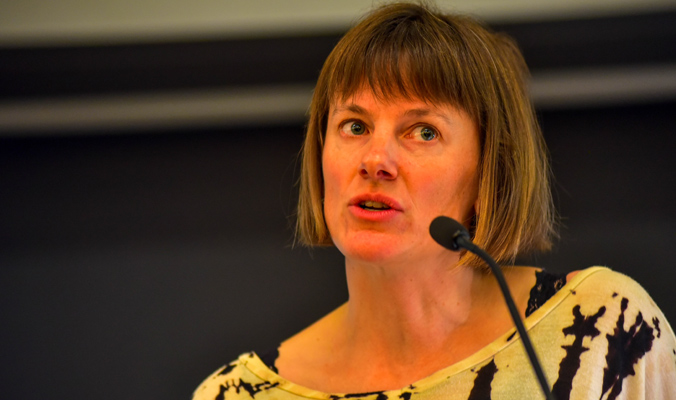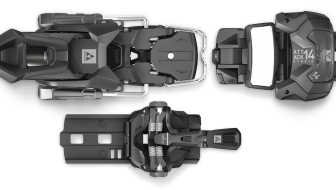Last Sunday, 600 people packed into a conference room at Seattle’s University of Washington for a full day of education and insight at the revamped Northwest Snow & Avalanche Workshop (NSAW). Organized and hosted this year by the Northwest Avalanche Center (NWAC), NSAW gathered 10 presenters, from guides and avalanche educators to paramedics and a behavioral psychologist, to discuss the latest in safety, science and decision making.
I was asked to participate on a panel titled The Future of the Backcountry: Where Will We Be In 2025? in which we talked telemark’s death, cell-phone-free backcountry zones, drones that might predict slope stability and more.
Here are nine things I learned at the workshop, and for more from the event, check out the #nsaw2015 hashtag on Twitter.
Practice With Your Airbag
Pascal Haegeli, an Assistant Professor at Simon Fraser University in B.C., presented his findings on the effectiveness of avalanche airbags—and they’re striking. In his research dataset, an airbag increased a user’s chance of avalanche survival by 11 percent while eliminating half of fatal burials. “If a medical treatment got results like this, it would be flying off the shelves like hotcakes,” Haegeli said. He also noted that airbags failed in 20 percent of accidents—of those failures, 60 percent was user error. The message? Check over your airbag and practice inflating it often, at least once a season.
We Need to Look Out For Each Other, Now More Than Ever
“We’re really interconnected,” said Trent Meisenheimer, a forecaster with the Utah Avalanche Center during his presentation titled How Freedom of the Hills Has Become Anarchy in the Backcountry. “It’s not just us out there. We’ve gotta realize that.” Meisenheimer and his Utah Avalanche Center colleagues propose developing a social contract or backcountry skier responsibility code to promote inter-group safety off piste. Check out Molly Loomis’s story Mountain Skills: Managing Risk and Responsibility for more.
Avalanche Education in the U.S. Is About To Change
“If you look at the avalanche education system across the United States, it’s kind of all over the charts,” said Dallas Glass, of the American Avalanche Association. “We actually need dedicated training for recreationists and dedicated training for professionals.” That change is coming in winter 2016-17, with separate, dedicated avalanche-education tracks for professional and recreationist. Read more about the change in James Roh’s story Mountain Skills: Why Take Avy Two?
![Dallas Glass, of the American Avalanche Institute, dishes on the pro/rec avy-education split. [Photo] Rick Meade, NWAC](http://backcountrymagazine.com/wp-content/uploads/2015/11/NSAW2.jpg)
Dallas Glass, of the American Avalanche Association, dishes on the pro/rec avy-education split. [Photo] Rick Meade, NWAC
Uncertainty Matters More Than We Know
“When people have good information about uncertainty, they tend to distinguish more; they tend to discriminate better,” said Susan Joslyn, a cognitive psychologist and Associate Professor at the University of Washington. Joslyn presented on how people understand uncertainty, stating that the best messaging suggests a most-likely outcome and offers advice and estimates of uncertainty—worthy notes when considering how avalanche forecasts are presented.
Ask More Often: What If I’m Wrong?
Margaret Wheeler, the second woman in the U.S. to complete her IFMGA certification, also delved into uncertainty, discussing overconfidence and overexposure in the mountains. “Uncertainty is underrepresented in our decision-making process,” Wheeler said, suggesting we should do more to quantify what we don’t know before making a backcountry decision. “Ask: What is our list of uncertainties?” Wheeler said. “We have to match increased exposure with increased vigilance.”

“It’s possible that we forget to focus on what we don’t know,” IFMGA guide Margaret Wheeler said during her presentation on overconfidence and overexposure in the mountains. [Photo] Rick Meade, NWAC
El Niño Isn’t All Bad For The PNW
With El Niño’s track record of bringing warm winters to the Northwest, this year’s predicted Godzilla El Niño might spell disaster. But it won’t be all bad, says Washington State Climatologist Nick Bond. According to Bond, the so-called “Blob” that brought a near snowless season to Washington last winter, has dissipated. For this winter, Bond says, “Our best estimate is that our snowpack will be 75 to 80 percent of normal.”
![Nick Bond, Washington State Climatologist, says El Niño won’t be all that bad for El Pacific Northwest. [Photo] Rick Meade, NWAC](http://backcountrymagazine.com/wp-content/uploads/2015/11/NSAW3.jpg)
Nick Bond, Washington State Climatologist, says El Niño won’t be all that bad for El Pacific Northwest. [Photo] Rick Meade, NWAC
Computers Can’t Quite Predict Stability
“Essentially, all models are wrong, but some are useful.” That’s how Kyle Van Peursem, a graduate student at Montana State University’s Snow and Avalanche Laboratory, started his presentation, quoting statistician George C.P. Box. Peursem is exploring how meteorology can apply to avalanche forecasting and whether or not weather forecasting can predict snow stability. “Numerical snowpack prediction systems probably won’t be the main tool for avalanche forecasting and wouldn’t replace manual observations,” Van Peursem said, “at least not in our lifetime.”
Assessing Hazards? Focus on Consequence and Likelihood
“The elements of consequence and likelihood are always linked in hazard evaluation,” said Martin Volken, owner of Pro Guiding Service. Volken proposed a simple, numerical scale of quantifying a hazard’s likelihood and consequence, adding the totals and determining whether or not that quantity falls beyond your level of acceptable risk. “Risk management in the mountains should be based on the rhythm of the mountains and the people that you’re with,” Volken said.
![Martin Volken, IFMGA and owner of Pro Guiding Services, talks hazard assessment. [Photo] Rick Meade, NWAC](http://backcountrymagazine.com/wp-content/uploads/2015/11/NSAW4.jpg)
Martin Volken, IFMGA and owner of Pro Guiding Service, talks hazard assessment. [Photo] Rick Meade, NWAC
Continue Your Education
Avalanche education doesn’t stop after taking an Avy 1 course, and NSAW was a refreshing reminder of the need to constantly brush up on skills and knowledge. For a listing of avalanche courses and refreshers nationwide, including NWAC’s Going Deep series, check out our Avalanche Resources page.











Related posts:
Mountain Skills: Ilya Storm on 20 years of education, safety and snow science
Mountain Skills: Manuel Genswein on 20 years of education, safety and snow science
Mountain Account: A third-party rescue in Utah’s Wasatch Mountains
Mountain Skills: Brian Lazar on 20 years of education, safety and snow science